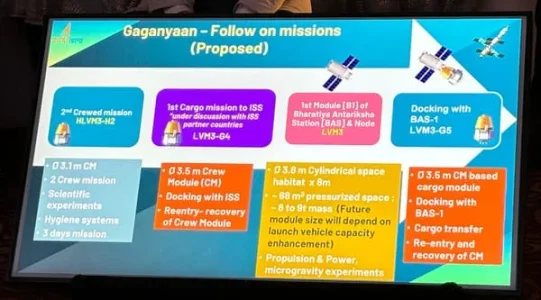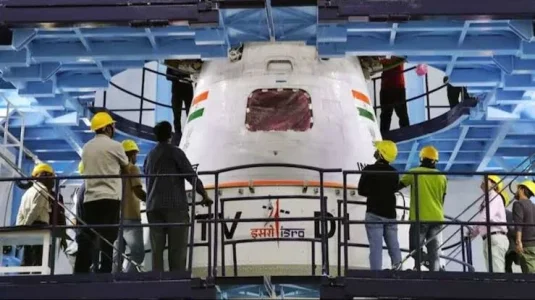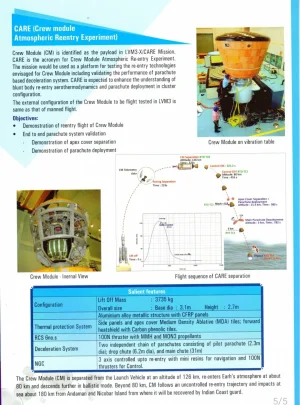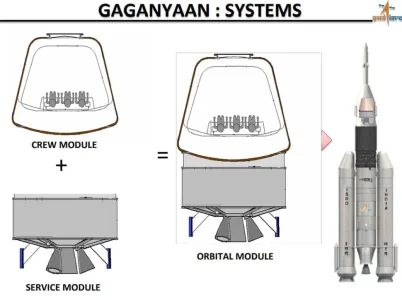You are using an out of date browser. It may not display this or other websites correctly.
You should upgrade or use an alternative browser.
You should upgrade or use an alternative browser.
Indian Human Spaceflight Programme (2 Viewers)
- Thread starter haldilal
- Start date
More options
Who Replied?- Joined
- Jun 27, 2024
- Messages
- 374
- Likes
- 2,024
Corrected title*
Gaganyaan is the spacecraft series mission name specifically, not all aspects of Indian Human Spaceflight Program in general.
Gaganyaan is the spacecraft series mission name specifically, not all aspects of Indian Human Spaceflight Program in general.
- Joined
- Jun 27, 2024
- Messages
- 2,937
- Likes
- 10,449
- Joined
- Jun 27, 2024
- Messages
- 4,231
- Likes
- 24,970

Two Gaganyaan astronauts shortlisted, one to travel to International Space Station on NASA mission this year
The mission will take place “no earlier than October 2024,” according to the information available on NASA website.
- Joined
- Jun 30, 2024
- Messages
- 1,795
- Likes
- 23,017

Moon Monday #183 and Indian Space Progress #17: The one where Chandrayaan and Gaganyaan converge
How will ISRO go from Chandrayaan 3 to an Indian on the Moon? Clarifying and laying down India’s plans for increasingly complex robotic lunar missions, where human spaceflight comes in, and what realistic timelines look like.

- Joined
- Jun 27, 2024
- Messages
- 374
- Likes
- 2,024

ISRO's Gaganyaan parachute production underway in Uttar Pradesh, set for completion in 3 months
The Ordnance Equipment Factory (OEF) in Hazratpur, Firozabad, located approximately three hours from Delhi, is actively engaged in manufacturing parachutes crucial for India's ambitious Gaganyaan miss
- Joined
- Jun 27, 2024
- Messages
- 374
- Likes
- 2,024
Enlisted Spacecraft Experiments
10 January 2007: SRE-1
SRE-1
550 kg
Launch Vehicle:
PSLV-C7 / CARTOSAT-2 / SRE-1
Type of Satellite:
Science & Exploration
Manufacturer:
ISRO
Owner:
ISRO
Application:
Experimental
Orbit Type:
SSPO

Crew module Atmospheric Re-entry Experiment (CARE)
Dec 18,2014
10 January 2007: SRE-1
SRE-1
Space Capsule Recovery Experiment (SRE – 1) is a 550 kg capsule intended to demonstrate the technology of an orbiting platform for performing experiments in micro gravity conditions. After completion of the experiments, the capsule was de-orbited and recovered. SRE – 1 mission provided a valuable experience in fields like navigation, guidance and control during the re-entry phase, hypersonic aero thermodynamic, development of reusable thermal protection system (TPS), recovery through deceleration and flotation, besides acquisition of basic technology for reusable launch vehicles.
Launch Mass:SRE – 1 carries two experiments, an Isothermal Heating Furnace (IHF) and a Bio-mimetic experiment. SRE was launched into a 635 km polar SSO in January 2007 as a co-passenger with CARTOSAT -2 and stayed in orbit for 10 days during which its payloads performed the operations they are intended to. The SRE capsule was de-boosted and recovered successfully back on earth on 22nd January 2007.
550 kg
Launch Vehicle:
PSLV-C7 / CARTOSAT-2 / SRE-1
Type of Satellite:
Science & Exploration
Manufacturer:
ISRO
Owner:
ISRO
Application:
Experimental
Orbit Type:
SSPO

Crew module Atmospheric Re-entry Experiment (CARE)
Dec 18,2014
Crew Module (CM) is identified as the payload in GSLV MK-III-X/CARE Mission. CARE is the acronym for Crew module Atmospheric Re-entry Experiment. The mission would be used as a platform for testing the re-entry technologies envisaged for Crew Module including validating the performance of parachute based deceleration system. CARE is expected to enhance the understanding of blunt body re-entry aerothermodynamics and parachute deployment in cluster configuration.
The external configuration of the Crew Module to be flight tested in GSLV MK-III is same as that of manned flight.
Objectives:
प्रमोचक राकेट / Launch Vehicle: LVM-3/CARE Mission
- Demonstration of reentry flight of Crew Module
- End to end parachute system validation
- Demonstration of apex cover separation
- Demonstration of parachute deployment
निर्माता / Manufacturer: ISRO
स्वामी / Owner: ISRO
अनुप्रयोग / Application: Experimental
The Crew Module (CM) is separated from the Launch Vehicle at an altitude of 126 km, re-enters Earth’s atmosphere at about 80 km and descends further in ballistic mode. Beyond 80 km, CM follows an uncontrolled re-entry trajectory and impacts at sea about 180 km from Andaman and Nicobar Island from where it will be recovered by Indian Coast guard.
- Joined
- Jun 27, 2024
- Messages
- 374
- Likes
- 2,024
- Joined
- Jun 27, 2024
- Messages
- 374
- Likes
- 2,024
Older Space Suit Concept from Sure Safety
View: https://youtu.be/92xvo_oTIgs
Suit features mentioned in above news clip:
View: https://youtu.be/92xvo_oTIgs
Suit features mentioned in above news clip:
- Seven layered, fire-retardant, water-repellent, puncture-proof
- Pressure controlled
- Chilling water cooled
- Umbilical connectors for suit-sensors, biometric sensors, air and oxygen supplies
- Has approx 200 parts including mechanical, electrical and plastic parts
- Weighs 13kg
- Developed in 4 years
- Joined
- Jun 27, 2024
- Messages
- 374
- Likes
- 2,024
Older article from 2016 for Deflab's Space Food

 www.newindianexpress.com
www.newindianexpress.com

Def lab works on food for spaceflight crew
CHENNAI: The Mysuru-based Defence Food Research Laboratory (DFRL) is planning to prepare food for India’s Human Spaceflight Programme that will carry a two-memb
- Joined
- Jun 27, 2024
- Messages
- 374
- Likes
- 2,024
- Joined
- Jun 27, 2024
- Messages
- 374
- Likes
- 2,024
- Joined
- Jun 27, 2024
- Messages
- 374
- Likes
- 2,024
- Joined
- Jun 27, 2024
- Messages
- 374
- Likes
- 2,024
- Joined
- Jun 27, 2024
- Messages
- 374
- Likes
- 2,024
Beginning of Crew Selection
Institute of Aerospace Medicine ties up with ISRO for life-support system
First Meeting of Gaganyaan National Advisory Council
Gaganyaan mission: IAF to pick 10 potential astronauts in 2 months, ISRO chief says
IAM patch borrowed from NSF

Institute of Aerospace Medicine ties up with ISRO for life-support system
First Meeting of Gaganyaan National Advisory Council
Gaganyaan mission: IAF to pick 10 potential astronauts in 2 months, ISRO chief says
IAM patch borrowed from NSF

- Joined
- Jun 27, 2024
- Messages
- 374
- Likes
- 2,024
More from past Timelines
Glavkosmos signs contract with ISRO for training Indian astronauts
Cabinet approves ISRO Technical Liaison Unit at Moscow
Gaganyaan: Level 1 of astronaut selection done in Bengaluru
IAF shortlists 10 test pilots who will go to space in manned mission Gaganyaan

 m.economictimes.com
m.economictimes.com
Containers and Foods for Gaganyaan Crew
View: https://x.com/ANI/status/1214417678632251393
Glavkosmos signs contract with ISRO for training Indian astronauts
Cabinet approves ISRO Technical Liaison Unit at Moscow
Gaganyaan: Level 1 of astronaut selection done in Bengaluru
IAF shortlists 10 test pilots who will go to space in manned mission Gaganyaan

RSP supplies special steel for 'Gaganyaan' project of ISRO
Gautam Banerjee, ED (Works) of RSP, a unit of SAIL flagged off the plates in a function organised at Plate Mill department on Saturday. The plates rolled from 14 slabs were the first lot of the total order quantity, the RSP statement said.
Containers and Foods for Gaganyaan Crew
View: https://x.com/ANI/status/1214417678632251393
Users who are viewing this thread
Total: 2 (members: 0, guests: 2)

Latest Replies
-
Indian Economy
- ezsasa
-
Indian Private Defence Sector
- Zoid Raptor
-
Indian Air Force: News & Discussions
- Noob_Saibot
-
Modernisation of Indian Army Infantry
- RDXChauhan
-
Report Bugs
- Bhartiya Sainik
-
Air India AI 171 Crash in Ahmedabad
- Bhartiya Sainik



















